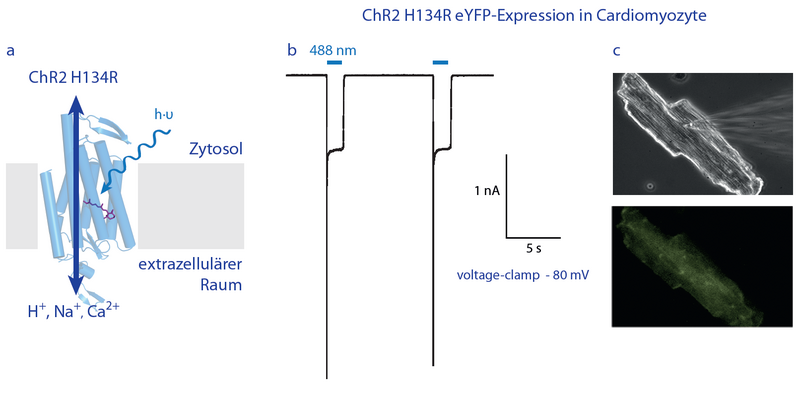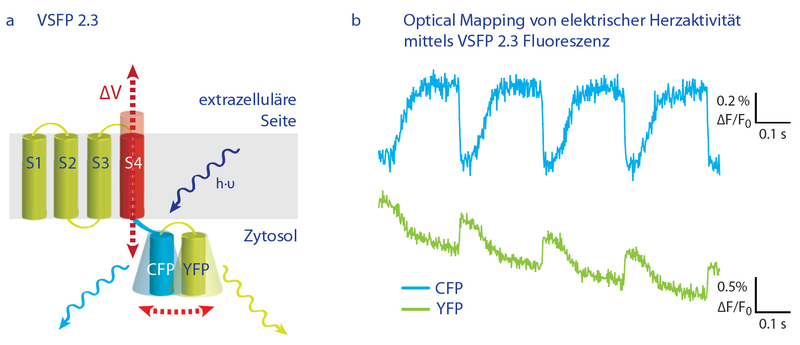Cardiac Optogenetics
The Optogenetics Group develops genetically encoded, light-activated tools to study the biophysics of cardiac processes, from single cell-signalling to whole-heart mechanoelectric activity.
Light-Activated Ion Currents
In optogenetics, microbial rhodopsins comprising light-activated cation channels (Channelrhodopsins/ChRs) and photo-activated pumps (Arch, Halorhodopsins) are commonly applied to modulate the electrical activity of excitable cells. Targeting photoreceptor proteins to the cells of interest is mediated by genetic methods, employing cell-type specific promoters or viral delivery using tissue-specific virus serotypes. Currently, we optimize optogenetic actuators developed for neurophysiology for use in cells of the cardiovascular system, and their relevant subcellular compartments (Fig. 1).
Fig. 1: Channelrhodopsin-2 (ChR2) can be applied to trigger inward-directed photocurrents in freshly isolated cardiomyocytes. a) Structural model of the ChR2 monomer based on the C1C2 structure (pdb 3UG9). The retinal chromophore is shown in magenta. b) Patch-clamp recording on cardiomyocytes showing large inward currents upon blue-light stimulation. c) Images depict isolated cardiomyocyte with patch-pipette. Upper image- phase contrast. Lower image- eYFP fluorescence.
Optogenetic Reporters
In addition to optical intervention systems, optogenetic tools include fluorescent proteins that are sensitive to cellular parameters such as membrane voltage, pH and intracellular Ca2+ concentration. We use the voltage-sensitive fluorescent protein (VSFP2.3), a FRET-based sensor of membrane voltage, to differentially explore electrical activity in heart muscle and connective tissue cells.
Fig. 2: Voltage-sensitive fluorescent proteins are sophisticated tools to monitor electrical cardiac activity. a) Cartoon depicting molecular structure and functional principle of VSFP 2.3. Membrane voltage changes induce reorientation of S4 which is transduced to the pair of fluorescent proteins, the cyan-fluorescent protein CFP and the yellow-fluorescent protein YFP. Förster resonance energy transfer (FRET) efficiency between the FRET donor CFP and FRET acceptor YFP is thus altered upon changes of membrane potential. b) Example traces of an optical mapping experiment recording electrical activity in the left ventricle (adult mice).
- Simon-Chica A, Fernández MC, Wülfers EM, Lother A, Hilgendorf I, Seemann G, Ravens U, Kohl P, Schneider-Warme F. Novel insights into the electrophysiology of murine cardiac macrophages: relevance of voltage-gated potassium channels. Cardiovasc Res 2022/118(3):798-813
- Zgierski-Johnston CM, Schneider-Warme F. Observing and manipulating cell-specific cardiac function with light. Adv Exp Med Biol 2021/1293:377-388
- Kopton RA [...] Moss R, Zgierski-Johnston CM [...] Kohl P, Quinn TA, Schneider-Warme F. Cardiac Electrophysiological Effects of Light-Activated Chloride Channels. Front Physiol 2018/9:1806
- Bernal Sierra YA*, Rost BR*, Pofahl M* [...] Kopton RA [...] Kohl P, Baier H, Schneider-Warme F [...] Schmitz D. Potassium channel-based optogenetic silencing. Nat Commun 2018/9:4611 (*equal contribution)
- Quinn AT, Camelliti P, Rog-Zielinska EA, Siedlecka U, Poggioli T, O'Tooled ET, Knöpfel T, Kohl P. Electrotonic coupling of excitable and nonexcitable cells in the heart revealed by optogenetics. PNAS 2016/doi: 10.1073/pnas.1611184114
- Schneider F, Grimm C and Hegemann P. Biophysics of channelrhodopsin. Annu Rev Biophys. 2015/44:167-86
- Optogenetics - Method of the Year 2010 Nature Methods 2011/8
Team

Dr. Franziska Schneider-Warme
Head of section

Leonardo Sacconi, PhD
Senior Scientist

Dragana Stefanovska

Sophia Ohnemus

Ana Simón Chica





